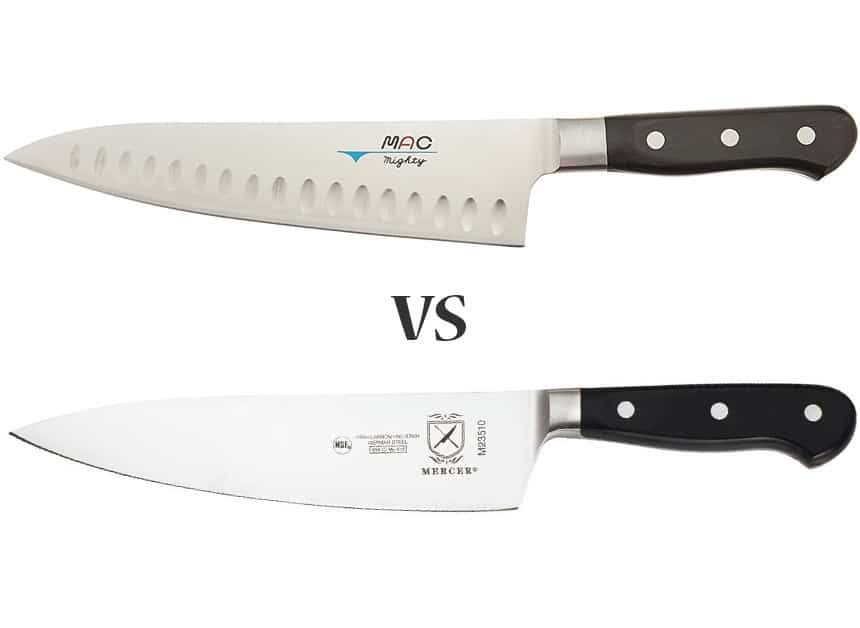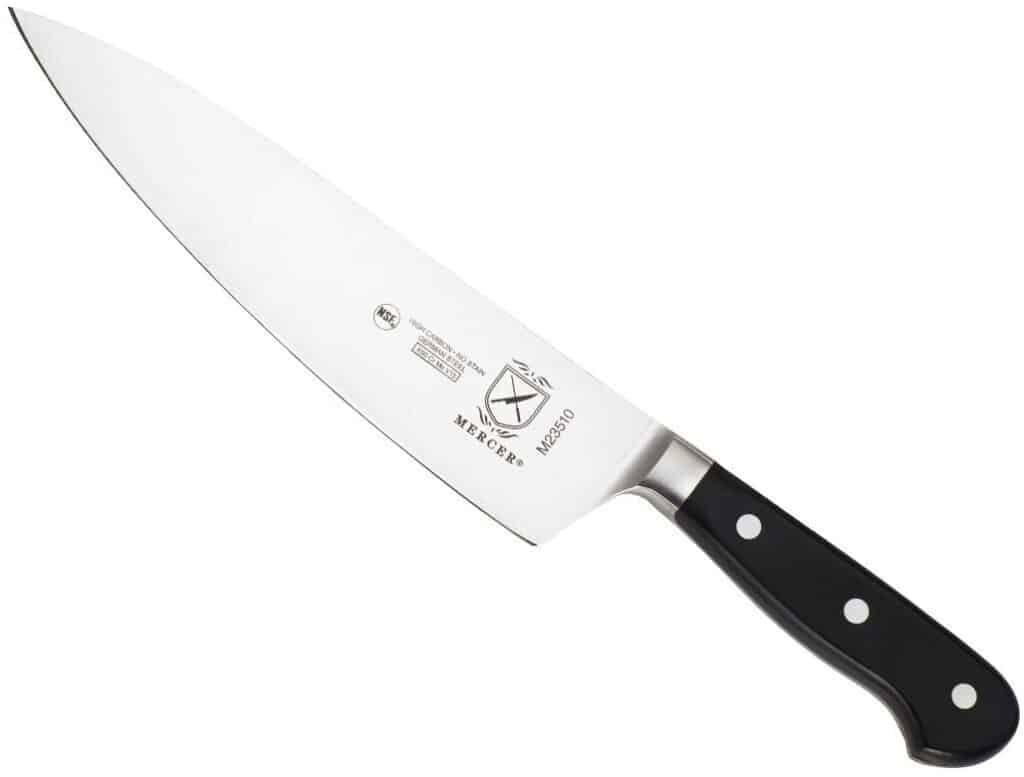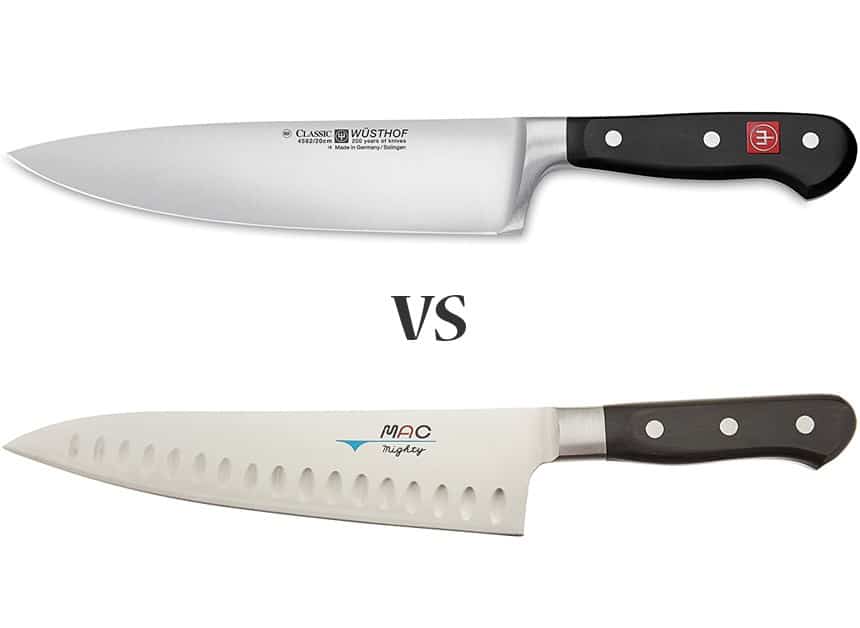
Knowing the real difference between knife brands is quite hard.
They all make big claims but, in truth, they often offer products of vastly different quality.
Two good brands people looking for a kitchen knife will often come along are Mac and Mercer.
Mac makes Japanese style knives, whilst Mercer make western-style knives. There are a lot of differences between the two, but which is right for you?
In this article, I’m going to tell you the differences between these two great brands. I’ll go in-depth into the details of each, talking about where they are made, what materials are used and the difference in price.
This should be all the information you need to select your perfect knife.
Mac knives offer a far superior, sharper cutting edge but they are significantly more expensive than Mercer knives. Mercer’s Renaissance range offers a good all-round western-style knife, but don’t expect it to be as sharp as a Mac.
| My recommendation | Current price |
| Mac Professional 8-Inch | View on Amazon (opens new tab) |
| Mercer Culinary Renaissance 8-Inch | View on Amazon (opens new tab) |
Mac vs Mercer – Comparison Table
Here is my summary comparison table for each brand. This is mostly based on their main range of knives; the Mac Professional and the Mercer Renaissance Chef’s Knife.
For a more in-depth look at each category then check out the rest of the article below.
| Category | Mac | Mercer |
| Country of Manufacture | Japan | Taiwan |
| Steel type | VG-5 | X50CrMoV15 |
| Rockwell hardness | HRC 59-61 | HRC 56-58 |
| Factory edge | ~15 degrees (double bevel) | 15 degrees (double bevel) |
| Handle material | Pakkawood (wood/resin composite) | POM (thermoplastic) |
| Price range | $160 – $180 (Professional) | $50 – $60 (Renaissance) |
| Main benefit | Far sharper | Low price for decent quality |
| My recommendation | 8-Inch Professional (view on Amazon) | Mercer Renaissance Chef’s Knife 8-Inch (View on Amazon) |
Mac vs Mercer – Where are they made
| Brand | Country of manufacture |
| Mac | Japan |
| Mercer | Taiwan |
All Mac knives are manufactured in the Japanese city of Seki. Seki is known as the knife capital of Japan, with a population of only 90,000 it lies around 150 miles from Toyoko but is the central hub for all of Japan’s major knife manufacturers.
Mac has been making knives since 1964, selling over 25 million of their fantastically designed East-meets-West knives.
Mercer manufactures their knives in Taiwan, using imported German steel.
Mercer is part of a growing trend in the knife industry of using quality materials, like German or Japanese steel, but basing the manufacture in low-cost countries, like China or, in Mercer’s case, Taiwan.
In the past, these less authentic brands have been of noticeably lower quality, but more and more these brands are actually producing knives of a comparable standard to their German or Japanese counterparts, for a much lower price.
Mac is clearly ‘the real deal’ in regard to being a truly Japanese manufacturer, whereas Mercer is a less authentic brand without nearly the same level of heritage.
Mac vs Mercer – What steel do they use
The steel used in knives will often change depending on which range you pick.
Here I’m going to focus on the most popular range for both Mac and Mercer knives.
For Mac that’s their ‘Professional’ range, sometimes referred to as their ‘Mighty’ range. For Mercer, it’s their ‘Renaissance’ range.
| Brand | Steel type | Rockwell hardness |
| Mac Professional | VG-5 | HRC 59-61 |
| Mercer Renaissance | X50CrMoV15 | HRC 56-58 |
The fact that Mac knives are Japanese and Mercer knives are German is clear to see once we begin to analyze the steel each of them uses.
The Mac Professional range uses the Japanese steel VG-5. All Mac knives are made from some version of the Takefu V-Gold (VG) steel varieties.
It’s a much harder steel than the Mercer X50CrMoV15 but as a result, it’s not quite as durable.
We can see why when we look at VG-5’s levels of Carbon, Vanadium and Chromium.
The Carbon level is much higher at around 0.75%. That makes the blade harder, allowing for a finer edge, but it also makes it more brittle and prone to chipping.
The Vanadium content is a little lower at around 0.15%, again this makes the steel less durable in general than the Mercer’s X50CrMoV15.
The Chromium content is high at around 14%, which’s a little lower than the Mercer’s X50CrMoV15 but still makes this a quality stainless steel that will be very resistant to rust.
The Mercer Renaissance range uses X50CrMoV15. This is a German steel that is used for the majority of Mercer knives.
It’s popular steel amongst producers of quality western-style knives. That’s because it has a particular focus on durability, whilst retaining enough strength for a sharp edge.
The main elements of interest within X50CrMoV15’s composition are Carbon, Vanadium and Chromium.
The Carbon content is 0.55%. That’s not particularly high when comparing it with other quality knives; however, it’s high enough to provide sufficient strength in the blade for a 15 – 20 degree angle on each side, which is standard for western knives.
The big benefit of not having a very high Carbon content is that higher Carbon steels are usually more brittle, therefore the 0.55% content keeps the blade durable.
That’s the same with the strong Vanadium of 0.4%, Vanadium improves the resistance to wear of the steel also adding to its durability.
The Chromium content is 15% is what the 15 in X50CrMoV15 represents. Chromium is vital for the durability of steel as it’s what makes stainless steel resistant to rust.
Steel need only be 10.5% to be considered stainless, so a 15% content is high and makes this a quality stainless steel, very unlikely to rust unless extremely mistreated by the owner.
Overall the main difference between the Mac’s VG-5 steel and Mercer’s X50CrMoV15 steel is that X50CrMoV15 has been made with a very strong focus on durability, whereas VG-5 is focused on hardness, allowing for a finer edge.
This is reflected in their comparative Rockwell Hardness (HRC). The Mac Professional knives have a much higher HRC than Mercer and thus the steel is a lot harder and able to hold a sharper edge.
Mac vs Mercer – How sharp are they
Once again I’m going to focus on the most popular knives from each brand for this comparison.
You will experience a far sharper edge using Mac knives than Mercer knives due to the steel of the Mac knives being much harder.
| Brand | Factory edge | Rockwell hardness |
| Mac Professional | ~15 degrees (double bevel) | HRC 59-61 |
| Mercer Renaissance | 15 degrees (double bevel) | HRC 56-58 |
Sharpness is vital when looking for a knife, but in this case, there’s a bit more to it than just looking at which knife has the smallest angle of its edge.
Usually, the smaller the angle the sharper the blade. However, there are other considerations that are particularly important when comparing these two knives.
Harder knives will hold a sharper edge for longer. The Mac uses much harder steel than the Mercer.
Mac uses Japanese steel and that tends to have a focus on hardness, in order to create a sharper edge.
So, even though Mercer Renaissance knives are made with a similar factory edge of 15 degrees, the Mac knife will actually hold its edge for much longer.
Mac also design the edge of their knife in an unusual way.
Whereas Mercer knives use a standard bevel edge, with each side of the knife slanting at the same 14-degree angle to form a point, Mac knives have an off-center angle to the edge.
That means that one side of the knife has a smaller angle than the other, a technique that results in a sharper blade.
It’s a mix between the Japanese style of a single bevel edge, which are incredibly sharp, and a western double bevel edge.
The combination of this edge design and the hard steel means that you will experience a sharper edge using Mac knives.
Mac vs Mercer – What are the handles made from
The material used for handles is a vital and often overlooked feature of any knife.
A quality handle is often the sign of a quality overall knife. Handles need to be made from a durable material that can withstand all the heat and moisture fluctuations knives can experience in the kitchen.
Once again we’ll focus on the two main ranges from each brand, the Mercer Renaissance and Mac Professional knives.
| Brand | Handle material |
| Mac Professional | Pakkawood (wood/resin composite) |
| Mercer Renaissance | POM (thermoplastic) |
Mercer use a thermoplastic material called POM (Polyoxymethylene) for their knife handles.
Materials like these are ideal for knife handles due to their extreme durability.
POM is specifically designed for high stiffness and stability, and being a thermoplastic means it’s also extremely resistant to temperature and moisture changes.
Mac use a wood/resin composite called Pakkawood for their knife handles.
Pakkawood is extremely common in knife handles for quality Japanese knives, although many non-Japanese knife manufacturers around the world have begun to use it as well.
Pakkawood is a great material for knife handles, it’s more dense and durable than real timber. That means it’s more resistant to wear and tear and won’t crack over time as timber handles might.
The versatility of design also makes it a popular choice, it can be dyed all sorts of colors and will often give the appearance of a true wood finish.
Pakkawood is very resilient to temperature and moisture changes and makes a terrific material of choice, it also adds to the Japanese influence of the knife with Pakkawood being a popular Japanese knife handle material.
Both POM and Pakkawood are top quality knife handle materials and suit the respective German and Japanese heritage of each knife.
Mac vs Mercer – How much do they cost
Both these brands have wide ranges of knives all at differing price ranges.
To allow for a fairer comparison I’ve categorized three of their major ranges that represent their highest and lowest cost knives.
I’ve tried to compare similar knives, sticking to 8 Inch Chef’s knives or the closest equivalent they have in the range. E.g. The Mac Ultimate is actually a 9-inch knife.
In brackets next to the general price range you’ll see the name of the range.
These prices are rough estimates. Prices do change over time but this is intended as a rough guide.
| Brand range | Mac | Mercer |
| Premium | > $200 (Ultimate) | Not Applicable |
| Standard | $160 – $180 (Professional) | $50 – $60 (Renaissance) |
| Value | $80 – $100 (Chef’s Series) | $15 – $25 (Millennia) |
What is clear is that these two brands offer their knives at very different price ranges.
Mercer is a brand that generally lies at the budget end of the price scale. That’s fine if it’s what you’re looking for. Mercer makes a really quality knife for what you pay.
However; the clear superiority of Mac knives shows in their price. As I’ve discussed above, the steel is much harder, and therefore sharper and the general build quality of Mac knives is on another level to the more budget Mercer.
Mac vs Mercer – What is the difference
Now that we have looked at the design, materials, background and price of these brands we can fully understand the difference, and you should be able to make an informed decision on which knife is correct for you.
The main difference between Mercer and Mac knives is the sharpness and durability, created from the steel used and the design of the edge.
| Brand | Main benefit |
| Mac | Far sharper |
| Mercer | Low price for decent quality |
The Mac is by far the sharper blade and that’s mainly what you’re paying the higher price for.
It’s a clever mix between a Japanese single bevel and a Western double bevel makes it sharper out of the factory, and the Japanese steel used, with its 0.75% Carbon content, means it will hold its sharp edge for significantly longer than a Mercer knife.
However, with its higher Carbon content and lower Vanadium content in comparison with the Mercer, the Mac will also be more brittle and prone to chipping.
That’s fine if you are able to take care of the knife, it won’t chip very easily.
Whilst the Mercer’s steel can’t compete with the Mac on sharpness, it is the more durable of the two. It’s more rust resistant and less like to chip along the blade.
That’s important if you don’t want to worry too much about maintaining your knife.
With that understood, it should now be easy to choose between the two knives.
Mac vs Mercer – Which is better for you
This is down to what you want from your kitchen knives.
For someone looking for an extremely sharp blade, the Mac is the obvious choice. For anyone interested in Japanese influenced knives, who will be able to care for the knife properly, I would recommend the Mac all day long.
Caring for a Mac is not exactly hard, all you need to do is store it individually, such as in a knife block, using a blade sheath, or on a magnetic strip.
Essentially, you want to avoid knocking the blade edge against other hard objects when you’re not using it.
In busy family kitchens, where knives are likely to be thrown into the kitchen sink, cutlery drawer, or dishwasher without a second thought, this can be difficult.
But you’re aware of how to look after the blade, and just ensure it is properly stored after use, then the Mac will provide a superior cutting edge.
For a busy family kitchen, where multiple people might be using the knife or it’s a risk of being damaged or left soaking in water, then I would recommend the Mercer.
It’s more durable than the Mac and will require less care and attention, and it’s inexpensive, so even if someone did manage to damage the knife, it’s not the end of the world!
The blade is still plenty sharp enough for a western knife and if you just want a reliable knife for really good value then the Mercer is the knife for you.
My Mac Recommendation

View the 8-Inch Professional Mac on Amazon (opens new tab)
For my Mac recommendation, I’m also going to the mid-range priced Professional Chef’s knife.
With this Japanese knife, you get a hard steel and unique blade design, allowing for a sharper edge.
The side of the knife is also dimpled, which reduces the surface area and thus stops food from sticking to the blade, another clever design touch.
The materials used are all premium quality and, although the Mac’s steel might not be as durable as the Mercer’s steel, for a Japanese knife with a large Carbon content it is actually very durable and at 14% Chromium is a good quality stainless steel too.
Some high-Carbon Japanese knives contain almost no Chromium at all and can begin to rust overnight if left wet, this Mac is a far cry from those.
It may not be as durable as the super-durable western-style knives, but when it comes to Japanese blades this Mac is a great balance between amazing sharpness and durability.
My Mercer Recommendation

View the 8-Inch Mercer Renaissance Chef’s Knife on Amazon (opens new tab)
This is one of the most expensive knives from Mercer, and it’s still only at the price of most other brands’ value ranges!
What you get for around $50 is very good value. X50CrMoV15 forged german steel, half bolster with a thermoplastic, triple-riveted handle, and a classic western chef’s knife design.
It’s a knife you just can’t be disappointed with at that price.
It may not be the genuine article in that it’s manufactured in Taiwan instead of Germany, but it’s still a quality knife and an absolute bargain.

